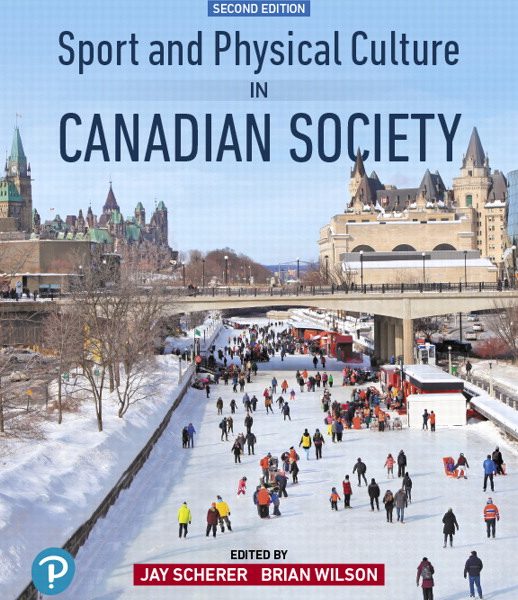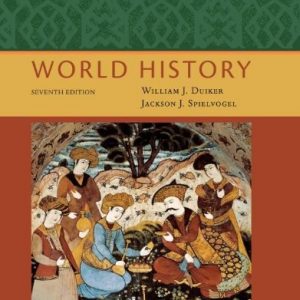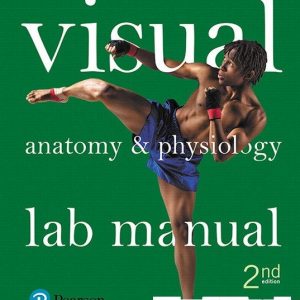Instant download Test Bank for Sport and Physical Culture in Canadian Society, 2nd Edition, Jay Scherer, Brian Wilson pdf docx epub after payment.

Product details:
- ISBN-10 : 0134682904
- ISBN-13 : 978-0134682907
- Author: Jay Scherer; Brian Wilson
Sport and Physical Culture in Canadian Society is based on the idea that historical, comparative, and critical reflection is needed if we are to better understand, and indeed work towards improving, relationships between and in sport, physical culture, and society. Students learn, for example, that the opportunities to participate in various sports in Canada are by no means equitable, and that significant and enduring issues and problems remain in contemporary sport and physical culture. More importantly, they learn that the personal troubles that individuals experience along these lines are intimately connected to public issues of social structure and historical relations.
Each chapter in this contributed text is written by experts in their field, using both Canadian and international perspectives to address contemporary sociological issues. The authors hope that this text will provide students with a sound basis for understanding the social dimensions of sport and physical activity from a uniquely Canadian perspective.
Table of contents:
- 1 Sport and Physical Culture in Canadian Society
- LEARNING OBJECTIVES
- Introduction
- Sociology as a Social Science
- Origins of the Sociology of Sport
- Defining Sport: Power at Play
- Defining Physical Culture
- The Sociological Imagination
- Key Sociological Concepts
- Social Structure and Agency
- Power
- Hegemony and Ideology
- Conclusion
- Key Terms
- Critical Thinking Questions
- Suggested Readings
- Endnote
- References
- 2 Thinking Sociologically: Sport, Physical Culture, and Critical Theory
- LEARNING OBJECTIVES
- Introduction
- Understanding Sociological Theory: General Themes and Historical Contexts
- Theory versus “Common Sense”
- Historical Context
- Putting Theories in Context
- Social Facts: Émile Durkheim and Structural Functionalism
- Émile Durkheim
- The Functions of Sport
- Criticisms of Functionalism
- Class and Goal-Rational Action: Karl Marx, Max Weber, and Conflict Theory
- Karl Marx
- Max Weber
- Conflict Theory and Sport
- Understanding Everyday Experiences: George Herbert Mead and Symbolic Interactionism
- George Herbert Mead
- Microsociology and Sport
- Critical Social Theories
- Critical Theories
- Gender Relations and Sexuality
- Critical Race Studies
- Conclusion
- Key Terms
- Critical Thinking Questions
- Suggested Readings
- References
- 3 Sport and Physical Culture in Historical Perspective
- LEARNING OBJECTIVES
- Introduction
- The Sociological Imagination and its Historical Sensitivity
- Applying a Historical Sensitivity
- The Humboldt Tragedy, Canadian Hockey, and the History of Organized Sport in Canada
- The Development of Organized Sport in Canada
- Hockey and Canadian Nationalism
- The Fight for Inclusion
- Indigenous Peoples, Racism, and Hockey
- Conclusion
- Key Terms
- Critical Thinking Questions
- Suggested Readings
- References
- 4 Sport and Social Stratification
- LEARNING OBJECTIVES
- Introduction
- Sport and Social Stratification: Some Preliminary Terms
- Social Inequality: The Canadian Profile
- Factors Contributing to Economic Inequality
- Early Theories of Class
- Karl Marx
- Max Weber
- Bourdieu’s Contemporary Theory
- Unequal Class Relations and the Financial Burden of Sport Participation
- Conclusion
- Key Terms
- Critical Thinking Questions
- Suggested Readings
- References
- 5 Physical Culture, Sport, Ethnicity, and Race in Canada
- LEARNING OBJECTIVES
- Introduction
- Terminology
- The Ethnic and Racial Structuring of Canada
- Race and Ethnic Relations
- Non-Whitestream Race- and Ethnic-Structured Sport Systems
- Using Theory to Make Sense of Ethnicity and Race in Sport and Physical Culture
- Francophones and Sport in Canada
- Race and Sport
- Racial Patterns in Canadian Sport: The Persistence of Whitestream Sport
- Indigenous Peoples and Sport
- Truth and Reconciliation Commission’s Calls to Action: Challenging Whitestream Sport
- Conclusion
- Key Terms
- Critical Thinking Questions
- Suggested Readings
- References
- 6 Sex, Gender, and Sexuality
- LEARNING OBJECTIVES
- Introduction
- Clarifying Our Terms
- Social Construction: A Framework for Thinking about Gender Norms
- Is Sport Really a Male Thing?
- Female Athletes in Sport Media
- Sex and Gender Differences in Sport
- Separate Events for Men and Women
- Sex Testing in Sport
- Transgender Athletes in Sex-Segregated Sport
- Lesbian and Gay Issues
- Feminism and Women’s Sport
- The Transformation of Women’s Sport
- Conclusion
- Key Terms
- Critical Thinking Questions
- Suggested Readings
- References
- 7 Youth Sport and Physical Culture
- LEARNING OBJECTIVES
- Introduction
- Prolympism and Defining “The Child”
- Youth Sport and Socialization
- Youth Sport Participation: How Many, Who, and in What Ways?
- Policies, Recommendations, and Guidelines about Young People
- Physical Literacy and Digital Health Technologies
- Dropout and Withdrawal in Youth Sport
- “Alternative” Youth Sport
- Parents, Coaches, Ethics, and Fair Play
- Conclusion
- Key Terms
- Critical Thinking Questions
- Suggested Readings
- References
- 8 Deviance, Sport, and Physical Culture
- LEARNING OBJECTIVES
- Introduction
- Conceptualizing Deviance
- Deviance and Otherness
- Deviantized Bodies and Embodiments
- Social Control
- Deviance on the “Field of Play”
- Drugs in Sport
- Which Drugs?
- Policing Performance-Enhancing Drugs
- Deviance off the Field of Play
- Deviantized Sports and Sporting Identities
- Conclusion
- Key Terms
- Critical Thinking Questions
- Suggested Readings
- References
- 9 Violence and Sport
- LEARNING OBJECTIVES
- Introduction
- Describing and Classifying Forms of Violence
- Theories of Violence
- Violence, Masculinity, and the Sociological Imagination: Historical Sensitivity
- Contemporary Sporting Violence
- Thinking Sociologically about Fighting in Hockey and “The Code”
- The Costs and Consequences of Violence
- A Critical Framework for Understanding Violence in Sport
- Three Forms of Male Athlete Violence
- Injury, Violence, and Sport Culture
- Sports-Related Violence: A Wider View
- Hazing in Sport
- Conclusion
- Key Terms
- Critical Thinking Questions
- Suggested Readings
- References
- 10 Sport and Health
- LEARNING OBJECTIVES
- Introduction
- The Health Implications of Conceptualizing the Body as Machine
- Sport as Panacea?
- Healthism and the Neoliberal Era
- The Darkest Side of the Culture of Risk
- Conclusion
- Key Terms
- Critical Thinking Questions
- Suggested Readings
- Endnote
- References
- 11 Sport, Media, and Ideology
- LEARNING OBJECTIVES
- Introduction
- The Sports–Media Complex
- Continuity and Change in the Canadian Sports–Media Complex
- The CTV Era
- A New Sport Broadcasting Order?
- The End of “Viewing Rights” for Canadians?
- The Ideological Role of the Media
- (Re)presenting Sport
- Gender and Sexuality
- Militarism and Nationalism
- Race and Ethnicity
- Sports Journalism: Critical Thinking?
- Conclusion
- Key Terms
- Critical Thinking Questions
- Suggested Readings
- Endnotes
- References
- 12 Sport, Politics, and Policy
- LEARNING OBJECTIVES
- Introduction
- Defining and Understanding Politics and Policy
- Where and How Do Sport and Politics Intersect?
- Sport and International/Global Politics
- Sport and National/State-Level Politics
- Sport and “Deep Politics”
- The Politics of Sports Mega-Events in Canada
- Vancouver 2010
- The Changing Politics of High Performance Sport and Athlete Assistance
- Conclusion
- Key Terms
- Critical Thinking Questions
- Suggested Readings
- Endnotes
- References
- 13 The Business of Sport
- LEARNING OBJECTIVES
- Introduction
- Overview of Professional Sports
- Canadian Football League
- Major League Baseball
- Major League Soccer
- National Basketball Association
- National Football League
- National Hockey League
- League Structure and Policy
- Cartels and Sports Leagues
- The Reserve Clause, Free Agency, and Monopsony Power
- Work Stoppages and Collective Bargaining
- Other League Policies
- Team Outcomes
- Ownership Forms
- Revenue Streams
- Public Policy on Sports Leagues
- Facility Construction Subsidies
- International Issues: The Olympic Games and World Cup
- Mega-Event Bidding and Costs
- Mega-Event Legacy Effects
- Conclusion
- Key Terms
- Critical Thinking Questions
- Suggested Readings
- Endnote
- References
- 14 Globalization, Sport, and International Development
- LEARNING OBJECTIVES
- Introduction
- Connecting Globalization to Sport
- Theories of Globalization, Development, and Inequality
- Globalization and Indigenous Peoples
- Globalization and Capitalism
- Approaching and Studying Globalization
- Globalization and International Development
- International Development and Postcolonialism
- Sport in Globalization and International Development
- The Emergence of SDP
People also search:
Sport and Physical Culture in Canadian Society, 2nd Edition
Sport and Physical Culture in Canadian Society, 2nd Edition pdf
Sport and Physical Culture in Canadian Society
sport culture examples
what is physical culture and sports
what is sports culture





